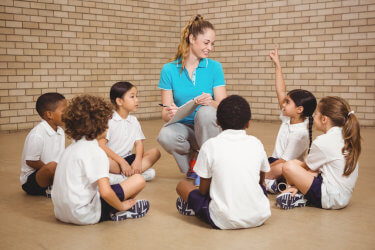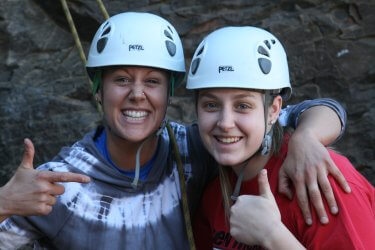Don’t Just be a Future Professional, Be the Future of the Profession
-A letter to future professionals-
To whom it may concern
When will “New PE” simply become PE? That’s a question I think about from time to time. It speaks not only to the direction of the profession, but also the stereotypical lens that outsiders view us through. It’s a question that pops in and out of my head, typically without too much consideration, and usually in a moment of reflection, or frustration. At last summer’s National PE Institute in North Carolina, presenter Naomi Hartl mentioned how she and Sarah Gietschier-Hartman had been discussing this same question. And Naomi had an answer.

In her keynote, Naomi talked about tipping points, and how they relate to this shift in mindset our profession needs. Simply put, a tipping point is when a movement generates so much momentum that it’s effects are irreversible (see Malcolm Gladwell’s excellent book for more).
Physical education’s tipping point will be when most teachers implement best practices into their instruction, making this approach the new normal. Naomi’s keynote (and all the keynotes for that matter) really spoke to me, and inspired me to speak out more for my students, my school, my colleagues both near and far, and my profession. And it’s that last piece, my profession, that nudged me to write to you.
Although conversations about “Old PE” vs “New PE” will likely continue, there should be no debate about our value. Physical education is a meaningful, relevant educational discipline, and needs to be treated as such. When I think about teaching physical education, I am always thinking about what’s next. My next lesson, my next assessment, my next dilemma, my next share, my next everything. Walking alongside my next’s however, are our next’s, the next in line, and that is all of you.
You are what’s next in PE. You are going to shape where we are in ten, twenty and thirty years. You will be the reason we reach the tipping point. When we stop being viewed as pseudo-education and start being regarded as an equal in the world of teaching. It will be you that comes up with the next teaching model or assessment strategy that enhances the learning process for our students. It will be you that gets us to the tipping point… but only if you want it to be.
At the moment, you are all considered future professionals. It’s a term that you should wear with pride, but a term that comes with a lot of responsibility. Our profession has grown a lot in recent years, and today many public-school teachers are doing tremendous things. However, for a true shift or tipping point to occur, current teachers need new teachers who join their districts to support their efforts.
How can you best support them? By following their lead regarding what it means to be a forward-thinking, dedicated physical educator. The teachers who are on the cutting edge cannot continue to exist as the minority. Realize that being an outstanding teacher is a difficult but immensely rewarding career. Below I offer some tips to keep you in the right frame of mind as you begin.

Understand that success is a journey
I don’t know about you, but I’ve learned that when I go on a journey I’m going to face twists and turns, mistakes and dead ends. Teaching is no different. You need to understand that not everything you try is going to work the way you want it to, not only in the beginning, but throughout your career. Lessons are going to go askew, and what looks great on paper may look a lot less great in real life, but that cannot stop you from trying things and being creative.
Do not be afraid to fail
A willingness to abandon the box and try new things is not only how we grow as professionals, but also how we continuously provide meaningful student-centered learning experiences. Recently, a fellow teacher inquiring about some of my lessons said, “I always look at stuff like that on paper and think it’s great, but wonder if it would really work?” My response was simple, “The only way to guarantee it won’t work, is to not try it at all!” Changing how people view physical education, and how students respond to expectations that may be new to them takes time. Trust in the fact that you are doing what’s right. Be reflective and constantly search for the best ways to get messages across to your students in an attempt to infuse meaningful learning and fun.
Persevere
Resistance to effective teaching in physical education is common. I’ve learned from speaking to teachers from many places, resistance to quality physical education is widespread. You can see resistance from all sorts of places, sometimes from the students themselves, but often from school colleagues and the community. You must never forget how important health and physical education knowledge and skills are to the overall development of our students.
Just the other day I was presented with an opportunity to advocate for our profession, and as usual I took it. Upon walking into the art room at my school to ask a colleague a question, I was introduced to a gentleman who was there to fix the sink. The art teacher introduced me as a health and physical education teacher, to which the plumber replied, “I loved gym.” The ensuing conversation went something like this:
Art Teacher: “Don’t tell Charlie he teaches gym.”
Plumber: “What’s the difference?”
Art Teacher: “Oh no, here we go!”
What followed was a very lighthearted conversation. I explained the difference between physical education and gym, and we all shared some laughs as he told me about his experiences in PE. I shared some insight as to how his classes differed from the classes I teach. When all was said and done I left thinking that this man was never introduced to some of the basic knowledge and skills necessary to live a healthy, active life. I am so glad my students are.
How does this relate to persevering? The answer is simple. This man represents a lot of the people you are going to interact with as you go through your career. People who liked PE class, but were never asked to demonstrate any sort of real learning. People who you are going to have conversations with time and time again over the course of your career, who may not see the incredible value physical education has to offer our students. These people view PE as a place to blow off steam, or think that our class is solely about playing games and sports. It’s your responsibility to educate them on the importance of the learning that must occur in physical education class to create healthy, well adjusted, physically literate young people. And it’s not a one-time effort. You must be voice the value of what you do and be willing to persevere with this message.
Find your marigold and beware of walnut trees
In an article posted on “Cult of Pedagogy” titled Find Your Marigold: The One Essential Rule for New Teachers, Jennifer Gonzalez discusses the impact of finding the right people to surround yourself with. Marigolds, she explains, are used by farmers “to help protect other plants from harmful weeds.” In contrast, walnut trees “give off toxic substances that can inhibit growth.” You’ll find both people in your district, building, and possibly your department. Be aware of the walnut trees and stay close to the marigolds. These are the people that want to help, want to share, want to advance our profession, want to educate students and want to see you succeed. Because at first it may be difficult to differentiate between the marigolds and the walnut trees, here are some distinctions:
| Marigolds | Walnut Trees |
| · Reflect when things do not go right, and try to make them better.
· Attend or lead professional development workshops and seminars in search of ways to enhance their own teaching.
· Look at teaching models designed for general education and try to see how they can be applicable to physical education.
· Are creative and open to new ideas.
· Dress and act professionally. |
· Blame the kids for not understanding or performing.
· Complain about “having” to attend workshops, or only attend to accumulate hours.
· Say, “that will never work with us” or “we are different” when presented a teaching model not specifically designed for physical education.
· Say, “we never did it that way.”
· Don’t try. |
At first, it may take time to decide who-is-who so be vigilant. Know who you want to be as an educator, and seek out those who can help you to get there.
Love what you do, every day
Know that there are going to be days when you want to quit, there are going to be days when you want to cry, and there are going to be days when everything just goes wrong. On those days, find a second to remember how lucky you are to be able to do what you do. Think about all the students that are counting on you to educate them, to listen to them, to inspire them, and to care about them. Think about what inspired you to be a teacher in the first place. Think about the difference you made to some kid in some way even though you were having a bad day. Go talk to a “marigold” and never forget students feed off your enthusiasm. They may not meet your expectations, they may not be as enthusiastic as you every day, but knowing that you care about them will make a difference. I hate clichés, but teachers who love teaching, really do teach students to love learning. To quote Rita Pierson, “Is this job tough? You betcha, oh god you betcha. But it is not impossible. We can do this, we’re educators, we were born to make a difference.”
Enjoy your professional journey!

All Future Professionals and 1st Time Attendees at the 2017 SHAPE America Convention next week are invited to attend a special “meet & greet” on Wednesday, Mar 15, 2017 from 9:30 AM – 10:00 AM prior to the day’s General Session. It will take place in Room 304/306 in the Convention Center. > http://convention.shapeamerica.org/Convention/For-Attendees/student_events.aspx. Hope to see you there!!